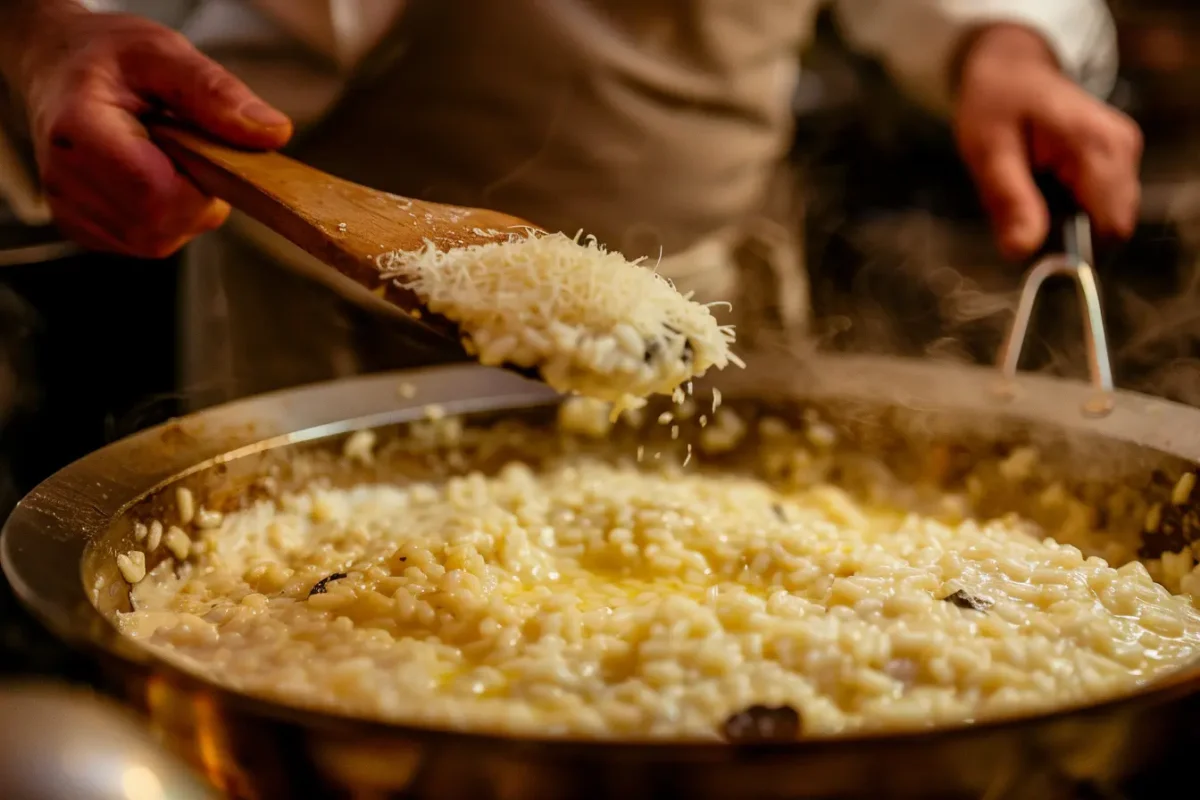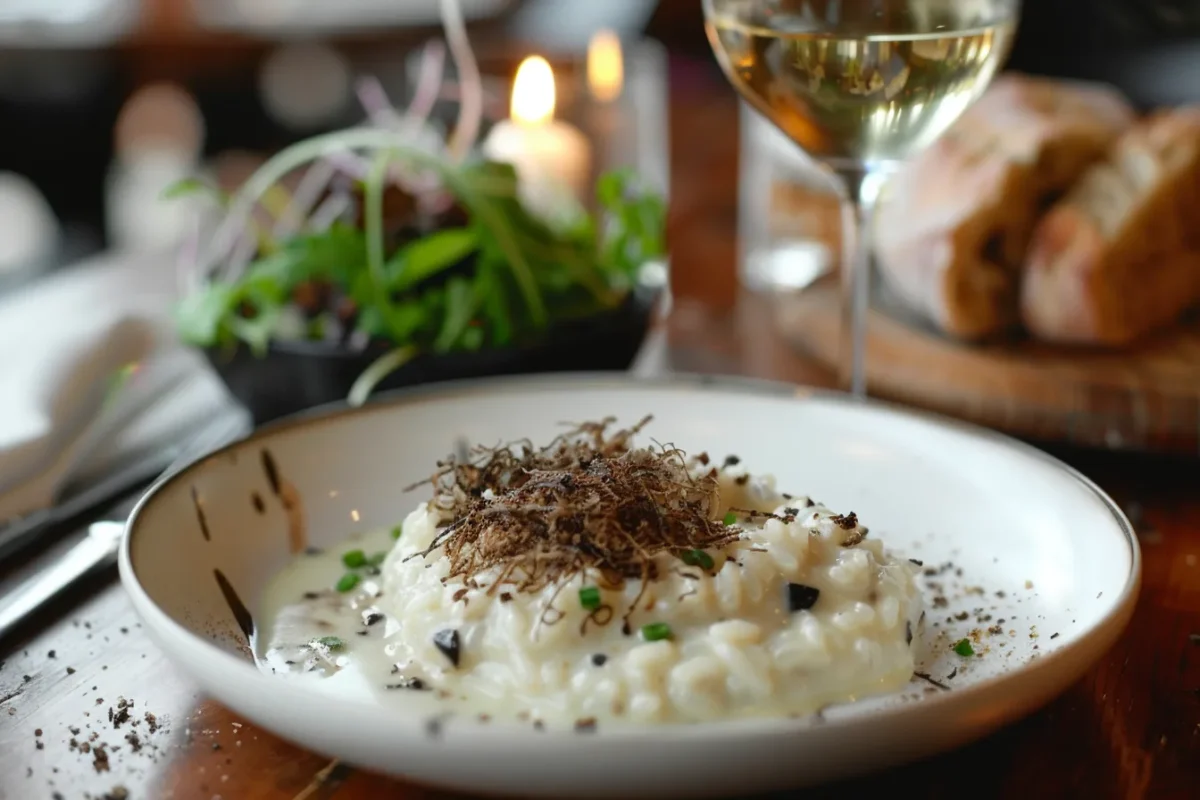Few dishes capture the essence of indulgence quite like truffle risotto. Rich, creamy, and infused with the unmistakable aroma of truffles, this Italian classic is a must-try for any food lover. Whether you’re a home cook eager to master the perfect risotto or a seasoned chef looking to refine your technique, this guide will walk you through everything you need to know.
From selecting the best ingredients to nailing the creamy consistency, we’ve got expert tips, creative variations, and pairing suggestions to elevate your risotto game. Ready to impress your guests (or treat yourself) with a dish that feels straight out of a fine dining restaurant? Let’s dive in—and don’t forget to share your results in the comments!
Jump to:
The Origins and Allure of Truffle Risotto
History of Risotto
Risotto has been a cornerstone of Italian cuisine for centuries. Born in the fertile regions of Northern Italy, this dish is rooted in the cultivation of short-grain rice varieties like Arborio and Carnaroli. Originally a simple peasant food, risotto evolved over time as cooks experimented with techniques and flavors, transforming it into the creamy delicacy we know today.
Truffle: The Crown Jewel of Ingredients
Why are truffles so revered? These underground fungi are nature’s treasure, with their potent aroma and distinct flavor adding depth to countless dishes. White truffles from Alba and black truffles from Umbria are particularly sought after, often referred to as the “diamonds of the kitchen.” Their rarity and labor-intensive harvesting make them a luxury ingredient in truffle risotto, elevating its status to culinary artistry.
Cultural Significance
In Italy, truffle risotto isn’t just a dish; it’s an experience. From autumn truffle festivals to lavish dinner parties, this dish symbolizes indulgence and celebration. Today, its fame extends far beyond Italy, gracing the menus of gourmet restaurants worldwide and becoming a favorite for food enthusiasts looking to recreate a bit of Italian magic at home.
With its rich history and unmatched flavor, truffle risotto is a dish that truly embodies the spirit of Italian cuisine. It’s no wonder that it has become a timeless favorite across the globe.
Essential Ingredients for Perfect Truffle Risotto
The Rice: A Foundation for Perfect Truffle Risotto
The heart of any good truffle risotto lies in the rice. Varieties like Arborio, Carnaroli, and Vialone Nano are renowned for their starchy content, which gives risotto its signature creamy texture. Among these, Carnaroli is often preferred for its ability to maintain a firm yet tender bite. Always choose high-quality rice to ensure the best results, as the starch released during cooking is vital to achieving that luscious consistency.
Truffle Varieties and Selection
Truffles are the stars of this dish, and selecting the right ones is key. Black truffles, with their robust and earthy flavor, are perfect for winter risottos, while white truffles, known for their delicate aroma, add a touch of elegance. Whether you opt for fresh truffles or truffle-infused products like oils or pastes, ensure they are sourced from reputable suppliers to avoid subpar quality.
Complementary Ingredients
Truffle risotto is a symphony of flavors, and each ingredient plays a role. Parmesan cheese lends a nutty richness, while a well-made stock—whether chicken, vegetable, or beef—provides depth. Avoid over-seasoning, as the truffles should take center stage. For an extra creamy finish, a dollop of butter or mascarpone can be stirred in at the end.
The success of your truffle risotto begins with thoughtful ingredient choices. Using the freshest and most flavorful components ensures a dish that truly shines.

Cooking Techniques for Truffle Risotto Mastery
Preparation is Key
A successful truffle risotto starts long before the pan hits the stove. Have all your ingredients prepped and measured—this practice, known as mise en place, ensures a smooth cooking process. From dicing onions to grating Parmesan, preparation can make or break the dish.
Step-by-Step Cooking Process
Mastering risotto is all about technique. Begin by sautéing onions in olive oil or butter until translucent—this forms the aromatic base. Next, add the rice, toasting it gently to lock in flavor. When it’s time to add stock, do so one ladleful at a time, stirring frequently. This gradual process allows the rice to absorb the liquid evenly, releasing starch and creating a creamy texture.
The Finishing Touch
Once the risotto reaches the perfect al dente consistency, it’s time to elevate it. Stir in grated Parmesan, fold in butter, and add freshly shaved truffles. This final step transforms a simple risotto into a masterpiece, with the truffles imparting their rich, earthy aroma.
Cooking truffle risotto is as much an art as it is a science. By paying attention to every detail, from preparation to finishing touches, you can craft a dish that’s nothing short of extraordinary.
Serving and Pairing Ideas
Creative Plating
Presentation matters, especially with a dish as elegant as truffle risotto. To wow your guests, consider using wide, shallow bowls to showcase the creamy texture. Garnish the dish with a light drizzle of truffle oil or freshly shaved truffles. For a modern twist, add a few edible flowers or a sprinkle of microgreens. The goal is to let the simplicity of the ingredients shine while adding a touch of sophistication.
Looking for a satisfying side dish or a complementary main course? Try these cheesy chicken wraps—a simple yet delicious option that pairs beautifully with the creamy richness of truffle risotto.
Ideal Wine Pairings
Pairing the right wine with your truffle risotto can elevate the meal to an unforgettable dining experience. White wines with a buttery or oaky profile, such as Chardonnay, complement the dish beautifully. If you prefer reds, a light Pinot Noir or Barbera works wonderfully without overpowering the delicate truffle flavors. For non-wine drinkers, sparkling water with a slice of lemon can cleanse the palate between bites.
Accompaniments
Truffle risotto is rich and luxurious, so lighter sides are ideal. A crisp arugula salad with a lemon vinaigrette offers a refreshing contrast. For a heartier option, serve it alongside grilled asparagus or roasted chicken. Traditionally, Italians might pair risotto with simple, seasonal vegetables or a small portion of grilled fish, keeping the meal balanced yet indulgent.
For more mouthwatering Italian recipes, be sure to explore our collection of classic dishes.

Variations of Truffle Risotto
Mushroom and Truffle Risotto
Adding mushrooms to your truffle risotto brings an extra layer of earthy goodness. Wild mushrooms like porcini or chanterelles pair exceptionally well with truffles, creating a robust and deeply flavorful dish. Simply sauté the mushrooms before stirring them into the risotto near the end of cooking.
Love experimenting with Italian flavors? If you’re looking to put a creative spin on your meal, why not start with an appetizer like Italian nachos? They bring a unique, crunchy contrast to the creamy texture of risotto.
Vegan and Dairy-Free Adaptations
Believe it or not, you can make a creamy and delicious vegan truffle risotto. Substitute vegetable stock for chicken stock and use a plant-based butter or cream alternative for richness. Nutritional yeast can replace Parmesan, delivering a cheesy flavor without dairy. Truffle oil or truffle paste adds the finishing touch, ensuring the dish retains its luxurious essence.
Fusion Styles
Why not take your truffle risotto on a global adventure? Incorporate Asian-inspired flavors with a splash of soy sauce and sesame oil or add a pinch of saffron for a Middle Eastern twist. These fusion variations breathe new life into a classic recipe, making it versatile and exciting for any palate.
No matter which variation you choose, truffle risotto proves its versatility and universal appeal. Whether you stick to the classic recipe or explore new flavor combinations, this dish promises to impress.
If you’re planning a multi-course meal, consider serving a flavorful appetizer alongside your risotto. These delicious sauces for Bang Potatoes can add an extra layer of indulgence to your dining experience
FAQs
What goes well with truffle risotto?
Truffle risotto pairs wonderfully with simple, complementary dishes that let the truffles shine. A fresh green salad with a tangy vinaigrette adds a refreshing contrast to the richness of the risotto. Lightly roasted vegetables, such as asparagus or zucchini, work beautifully as sides. For a more substantial pairing, opt for seared scallops or a perfectly grilled steak, which add a touch of protein without overpowering the truffles’ delicate flavor.
What should you not pair with truffles?
When serving truffle risotto, avoid bold, overpowering flavors that can compete with the truffles’ subtle aroma. Strongly spiced or heavily acidic dishes can clash with the earthy tones of the truffles. Similarly, overly sweet wines or desserts served alongside the risotto may diminish its savory appeal. The goal is to choose complementary items that enhance rather than overshadow the dish.
What not to do with risotto?
Risotto can be deceptively simple, but there are a few pitfalls to avoid. Don’t rush the process—adding stock too quickly can result in unevenly cooked rice. Resist the urge to over-stir, as this can break the rice grains and turn the dish mushy. Finally, avoid overloading the risotto with too many ingredients; the beauty of truffle risotto lies in its simplicity and the way it highlights the star ingredient.
What do Italians eat risotto with?
In Italy, risotto is often enjoyed as a primo (first course) rather than a main dish. It might be followed by a light protein, such as roasted fish or chicken. Italians value seasonality, so sides often include fresh, locally sourced vegetables. A glass of crisp white wine or a sparkling prosecco completes the meal, embodying the essence of Italian dining.
What cheese goes with truffle?
When it comes to pairing cheese with truffles, simplicity is key. Parmesan cheese is the classic choice for truffle risotto, as its nutty flavor enhances the truffle’s earthy notes without overwhelming it. Pecorino Romano, with its slightly sharper profile, is another great option. For a creamier touch, try mascarpone or even a mild ricotta. These cheeses bring out the best in truffles, creating a harmonious balance of flavors.
Why are truffles not vegetarian?
Truffles themselves are fungi and therefore vegetarian, but the method of harvesting them can raise concerns for some vegetarians. Traditionally, truffle hunters use trained pigs or dogs to locate truffles underground. While this doesn’t harm the animals, the ethical concerns arise from the use of animals in the process. Additionally, many truffle-flavored products, such as truffle-infused cheeses or oils, may contain animal-based additives, so vegetarians should check labels carefully.
Conclusion
Mastering truffle risotto is more than just learning a recipe—it’s about embracing the art of Italian cooking. With its luxurious texture and rich, earthy aroma, this dish brings elegance to any table, whether it’s a cozy dinner at home or a special gathering with friends. By using high-quality ingredients, following the right techniques, and keeping the flavors balanced, you can create a restaurant-worthy risotto that highlights the magic of truffles.
“Great food is all about patience, passion, and simplicity—and truffle risotto is the perfect example of that.”
Final Thoughts
Cooking is an experience, and truffle risotto is one worth savoring. Whether you stick to the classic recipe or experiment with variations, each bowl tells a story of craftsmanship and flavor. Don’t be afraid to make it your own—pair it with your favorite wine, add seasonal ingredients, or try different truffle varieties to create a dish that reflects your personal taste.
Call to Action
Now it’s your turn! Have you ever made truffle risotto before? What’s your favorite way to enjoy it? Share your experiences, tips, or even photos in the comments below. Let’s talk all things risotto! 🍽️✨

